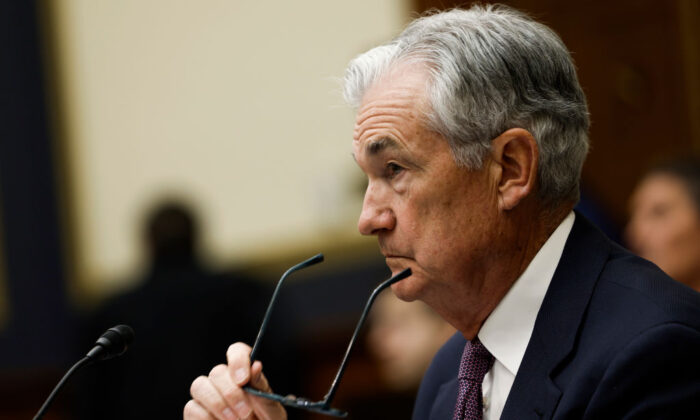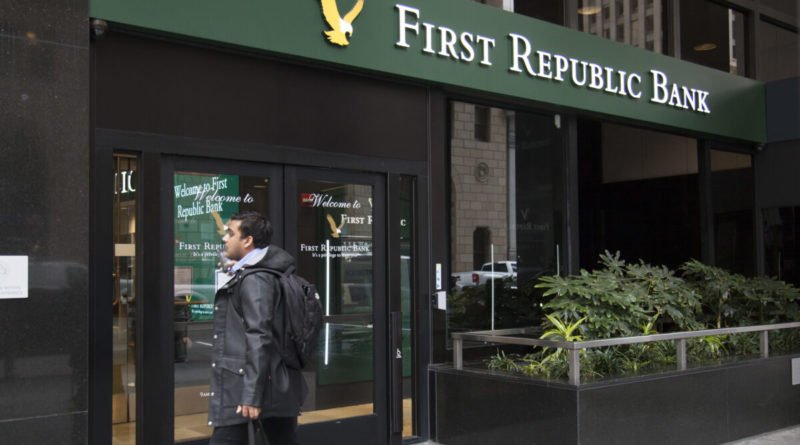Depositors Line Up Outside First Republic Branches Across California
Customers of First Republic—the San Francisco-headquartered bank that caters to high-net-worth clients and businesses—were lining up at various California branches ton Monday following the collapse of Silicon Valley Bank (SVB) and Signature Bank over the weekend. That day waiting outside First Republic’s Montgomery Street branch in San Francisco, a California business owner named Chad told The Epoch Times that he is concerned about whether he can withdraw his more than $1 million stored at the bank. The business owner had just finished transferring funds from SVB—where he was also a customer—and is now trying to diversify.
“We’ve transferred some money into Wells [Fargo] as well,” he said. “We’ve spread out our risk.”
Chad said recent events, though, have shaken his confidence in small regional banks.
To start the week, First Republic’s stock price fell 78 percent, reaching $18 per share, before rallying back above $35 later in the day.
Customer Lance Keefer, a former construction contractor, stopped by his branch in Brentwood, Calif. Social media chatter motivated him to visit in person to ensure his funds were secured. “It makes us all a little edgy,” Keefer told The Epoch Times.
Several other customers also were lined up on Monday morning before the Brentwood branch opened.
Another depositor, Robb Strom, came to check on his account and was told his money was safe and that the bank was still liquid and issuing loans. He remains wary, however.
“When the stock price goes down 60 percent in one morning, it’s concerning,” Strom said.
Mei Chi, the Vice President of finance at Platina Systems, told The Epoch Times that First Republic had not provided much information, leaving her to fend for herself. “Everything we learned was pretty much from periodicals,” she said.
Platina Systems has 15 employees.
Similarities to Silicon Valley Bank
Economists are pointing to similarities between the failed tech banks and First Republic, which have the public concerned. One market commentator called the SVB collapse “an old-fashioned 1930s’ liquidity crisis,” saying it had more to do with depositors pulling their cash than with the bank’s imprudent investments.
“This is not a solvency crisis like 2008. Bad loans or poor investments were not made.” said macro-analyst Jim Bianco on Twitter. “Too many depositors demanded cash at once, and SVB could not convert loans and securities to cash that quickly.”
Bianco warned that with today’s frictionless “world of mobile banking,” depositors were able to demand $42 billion on Mar. 10 without needing to wait in line and speak directly to a teller.
“This should scare the hell [out] of bankers and regulators worldwide,” he said. “The entire $17 trillion deposit base is now on a hair trigger expecting instant liquidity.”
Like SVB, First Republic holds a large number of funds on behalf of relatively few depositors, with one-fifth of the depositors of similarly sized banks. Most of these deposits are held on behalf of businesses with 68 percent uninsured—meaning not covered under the Federal Deposit Insurance Corporation’s reimbursement program—compared to SVB’s 90 percent.
If First Republic depositors withdraw their funds, it could spell trouble for the San Franciscan bank, given that it remains uncertain whether the bank will qualify for the government’s emergency measures.
On Mar. 12, the Federal Reserve announced a new lending program to “assure banks can meet the needs of all their depositors.” While this was intended to quell the growing panic, it did little to arrest the fall in First Republic’s share price.
The trouble may lie in the bank’s asset portfolio.

According to the Fed’s announcement, institutions that wish to receive emergency funds must pledge U.S. Treasury bonds, mortgage-backed securities (MBS), or “other qualifying assets” as collateral. While it is unclear which other assets might qualify, First Republic does not own many Treasuries or MBS assets.
Joseph Wang, a former trader at the Fed’s Open Markets Trading Desk, wrote on Twitter that the bank “can’t benefit from the Fed’s new bailout facility.” He suggested this could be related to the bank’s tanking stock price.
“You need Treasurys and agency MBS to tap the facility, and they barely own any.”
Still, Wang is not worried about the bank’s prospects. Even if certain assets do not qualify, he thinks regulators will bend the rules to avoid a crisis.
“I am not as concerned about First Republic because the authorities will likely do whatever it takes to save them,” he told The Epoch Times. Wang added that the bailout for depositors could reignite the inflation that the Fed has been working hard to contain.
Silver Lining
First Republic and a slew of other small- to medium-size banks are still faced with daunting liabilities on their balance sheets.
As MarketWatch reported on Mar. 10, First Republic showed a negative $331 million accumulated other comprehensive income (AOCI)—a metric that includes unrealized losses on owned assets and future losses for fixed liabilities like employee retirement plans. Compared to other banks, however, it may be in good shape.
The losses account for just 1.9 percent of First Republic’s total equity capital—a measure of a corporation’s total wealth—while several similarly sized banks have AOCI losses of over 10 percent.
Consider the Detroit-based Ally Financial, with an AOCI of negative $4.05 billion, representing 24 percent of the bank’s total equity capital. Both Ally Financial and First Republic manage around $200 billion in assets.
Despite the mismatch, Ally Financial’s stock price did not suffer nearly as much as First Republic’s, down about 10 percent on the day compared to 50 percent, respectively.
Lear Zhou, Jillian McLaughlin, and Steve Ipsas contributed to this article.




